Author: Wan Lianshan
At 2 a.m., the U.S. government announced that it would increase tariffs on China to 104%, effective immediately.
104% is basically a hard decoupling, and the short-term pressure is extremely huge.
You can refer to the situation when the mask was banned.
Prices in the United States have skyrocketed, and the government has been forced to use helicopters to directly distribute money to the people...
So when the news came out, the U.S. stocks that had risen sharply immediately turned to a sharp drop, and U.S. bonds also followed suit with violent fluctuations, with the interest rate on 30-year Treasury bonds rising by 10 BP.
Who is reducing holdings? It goes without saying.
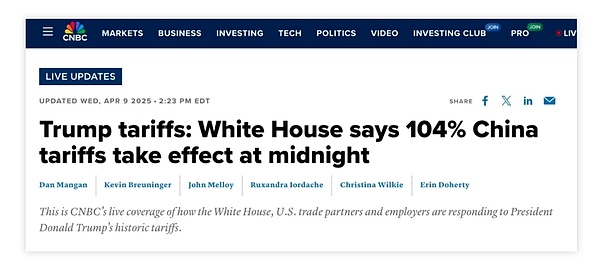
And the situation ahead does not seem optimistic.
If it were the international environment ten years ago, there might still be room for change.
But in recent years, countries around the world have clearly turned to the right, and the newly elected governments are tougher than the last...
For example, here, everyone can clearly feel that there are fewer official condemnations and more actual confrontations.
As expected, we will soon see that, except for a few compromises, most major countries will rush to implement retaliatory tariffs and strengthen trade barriers.
There is no way, if others add tariffs, you will suffer if you don't.
This also means that the globalization process, which has been less than 40 years, may have come to an end.
Of course, it can also be viewed from another perspective.
Global free trade has been maintained for decades and has run through the lives of nearly two generations, causing many people to become accustomed to this order and subconsciously think that this is the norm.
But in a longer time scale, free trade is actually a rare thing.
Protectionism is the norm.
How great?
Many people compare Trump to figures in Chinese history.
Some people think he is like Chongzhen, who messed around and had the opposite effect; others think he is like Liu Bang, who was a rogue but had many supporters...
But the series of things that have happened now have made people think of Wang Mang.
Trump said that one of the people he admires most is John Quincy Adams, the sixth president of the United States.
And what he is doing now seems to be following the footsteps of this ancient man who "made America great"...
The behavior is extremely unexpected, seemingly crazy and beyond the times, but it is an extreme retro movement - trying to pull the United States back to the era before the 20th century, when he thinks America was truly great.
In that era, the United States' industrial and economic strength advanced by leaps and bounds, surpassing Britain in a very short period of time; it was also strong in military power, with an average annual territorial expansion of 69,000 square kilometers, second only to the Mongol Empire in human history, and even Russia was inferior.
To some extent, it is somewhat similar to Khomeini's abandonment of secularization and use of medieval religious law to rule Iran in an attempt to revive the Islamic world.
But as we all know, Khomeini failed, and Iran became increasingly poor in the hands of his disciples.
And now, the mainstream public opinion around the world, including a large part of the people in the United States, almost all say that Trump is an unreasonable lunatic.
It has almost defined him as a loser.
There is no need to say more mocking and derogatory words.
Instead of endlessly engaging in a war of words, it is better to look at this matter from a broader perspective.
…
Looking back at the history of US tariffs, there are three peaks.
1828, 1930, and 2025 when the "reciprocal tariff" policy will be implemented.
The interval between them is about 100 years.
This is a very strange cycle, but it objectively exists.
Let's try to start from the root.
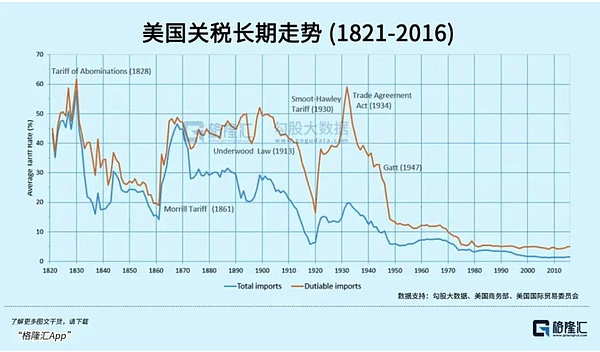
Based on the economic history data of the Maddison Project Database, see the figure below. As early as 1720, the per capita output of the 13 colonies surpassed that of Germany and France, second only to the United Kingdom.
In terms of wealth alone, it can be said to be the second most developed economy in the world.
As an important dumping ground for the mother country, local tariffs were high for a long time throughout the colonial period, but this tax was collected by the British.
For example, after the Seven Years' War, although Britain gained world dominance, it was also severely damaged and urgently needed blood transfusions from the colonies.
Therefore, the Tea Tax Act, the Donald Tax Act, the Stamp Act, etc. were promulgated, and colonial customs were established to impose import taxes on goods entering North America.
What does it mean? Not only must you buy my goods, but I will also raise prices in disguised form through tariffs.
In December 1773, the "Sons of Liberty" in Boston could no longer tolerate the exploitation and poured 342 boxes of East India Company tea into the sea, causing the "Boston Tea Party".
Rebellions broke out one after another, and eventually triggered the War of Independence.
After independence, the British and the damn tariffs were gone, and everyone ushered in free trade.
But still look at the figure below. For more than 20 years, the growth of per capita output in the United States almost stagnated, and was even worse than before the founding of the country.
At this moment, differences emerged.
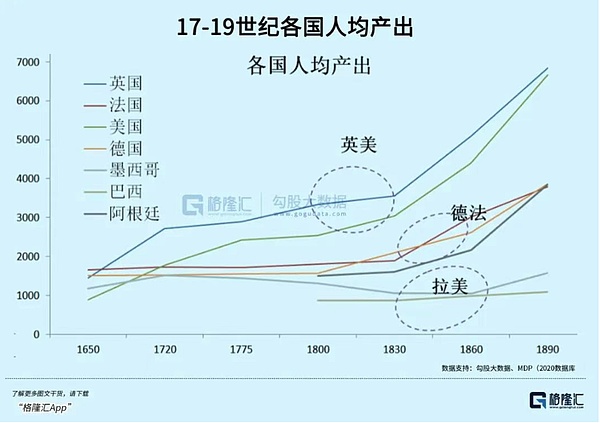
Before the United States "became great", the country was roughly divided into two factions.
The northern industrial manufacturing economy represented by Alexander Hamilton, and the southern slave plantation economy represented by Thomas Jefferson.
The former believed that the US industry was weak and that heavy taxes must be imposed on imported goods to protect the country's manufacturing industry.
But it is obvious that if you impose import taxes, other countries will certainly impose reciprocal tariffs in retaliation.
For factory owners, this consequence is not a big deal.
Because at that time, American industrial products had basically no market overseas, so what if they were taxed? Instead of worrying about these, it is better to support local manufacturing and eat up the domestic market.
At that time, there were only about 10 textile mills in the entire United States.
In 1789, the first Congress passed the first tariff bill, imposing tariffs on 81 commodities with an average tax rate of 8.5% to counter British dumping.
Thanks to this, by 1810, the number of factories in the United States had grown to 240.
Obviously, tariffs have a significant effect on supporting local industries.
But this is not very friendly to farmers in the South.

At that time, the main agricultural products in the United States were cotton and tobacco, which had been an industry for hundreds of years. The local industrial capacity could not be consumed at all, and it has always been mainly exported.
By raising tariffs, not only did their export profits drop significantly, but the cost of purchasing production tools also increased significantly.
Blood loss.
The Anglo-American War of 1812-1815 made American politicians realize how important industry was, and introduced the Tariff Act of 1816, raising the average tariff to 25%, and the tax rate on textiles as high as 33%.
Britain urgently needed to raise retaliatory tariffs, causing US cotton exports to drop from $22 million in 1820 to $18 million in 1826.
In 1828, the sixth president of the United States, John Quincy Adams, once again proposed the "Abominable Tariff" Act, raising the average tax rate to 45%.
Objectively speaking, the development of industry is the progress of the times.
But the farmers who paid the price obviously would not agree with this statement. Southerners angrily accused the government of "sacrificing agricultural interests to subsidize industry".

What is more critical?
As the scale of northern industry grew, the demand for labor also increased, so they tried to make the vast number of black slaves become workers.
This is tantamount to digging up the ancestors' graves of the farmers.
The United States was already suffocated by high tariffs, and now it had to abolish slavery and increase the cost of employment! ?
In order to ease the conflict, the federal government had to lower tariffs three times in 1845, 1855, and 1860.
But in 1861, with the promulgation of the Morrill Tariff Act, Lincoln, who insisted on high tariffs and abolition of slavery, came to power, and the conflict between the North and the South could no longer be eased, and the Civil War broke out.
The Northerners unified the country and the right to speak, and successfully turned the United States into the country with the highest tariff barriers in the world, and the local industry accumulated at an unprecedented speed.
By 1894, the total industrial output value of the United States officially surpassed that of Britain, and its share of the world jumped to 30%, becoming the new world factory.
This position was maintained for 116 years until it was surpassed by China in 2011.
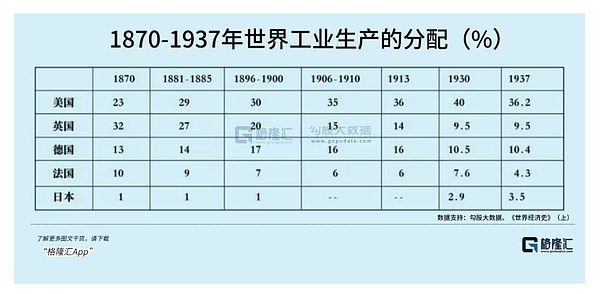
The above is a relatively one-sided and brief process of the United States from its infancy to "greatness" from the perspective of tariffs, and it has achieved the goal of becoming an industrial power.
And this is naturally Trump's ultimate goal of "making America great again."
But can the method used two centuries ago have a similar effect today?
Realistic Problems
Trump's original intention in launching a tariff war was to follow the example of Andrew Jackson, John Quincy Adams, Abraham Lincoln and other predecessors.
But in public opinion, most people think that he is a replica of Hoover, who caused the Great Depression in the 1930s.
To be honest, there are indeed many similarities between Hoover and Trump.
But Trump must feel that he is wronged.
During the Hoover era, the United States' industrial output value accounted for 40% of the world's total, making it the world's largest trade surplus country with a very serious overcapacity.
And the United States in the 21st century is the world's largest trade deficit country.
The underlying logic of the two tariffs is completely different.
……
Time goes back to the present.
Trump wants the United States to return to the "great era", which is definitely impossible with tariffs alone.
It is easy to add tariffs, but it is difficult to have actual goods to supply domestic and even overseas markets.
In particular, the United States once spent more than a hundred years and the efforts of several generations to complete industrialization and become the world's factory; now that the United States has actually deindustrialized, if it wants to re-industrialize and even rebuild the world's factory, there are at least four direct problems:
1. Labor
As of 2024, the total number of working people in the United States is 167 million, and the actual number of employed people is far less than this number.
80% of them are engaged in the service industry, and the number of employees in the secondary industry has long remained at around 10 million.
In contrast, the number of employees in China's secondary industry is as high as 210 million...
Without a huge leap in productivity, it will be very difficult for the United States to rebuild the world's factory with the current labor force size.
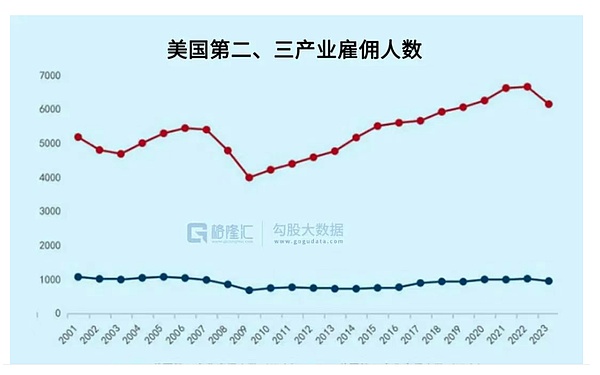
2. Industrial Chain
Although the United States has mastered most of the world's cutting-edge technologies, it has lost a large number of basic industrial chains since deindustrialization half a century ago, and practical technology is a shortcoming.
Of the 666 small industrial categories and 41 large industrial categories, less than 5% can be independent.
Take industrial raw materials as an example. The United States does not lack minerals, but it lacks processing industries; while China accounts for more than 40% of the world's largest industrial raw materials market share.
Once the manufacturing industry is redeveloped, and the import of Chinese goods is restricted, how can this problem be solved?
Although it is possible to support the processing industry in other markets... Let alone whether it can be built, the time and money costs are unimaginable.

3.Energy
Or to be more specific, how to solve the power supply problem?
In 2023, the total power generation in the United States will be about 4.3 trillion kWh, and industrial power consumption will be about 1.01 trillion kWh, accounting for about 23.6%.
Compared with other countries, 1 trillion kWh of industrial power consumption seems huge.
But for the United States, the former world factory, it is actually still at the level of the 1990s, which clearly reflects the phenomenon of deindustrialization in the past three decades.
In contrast, China's total power generation in 2023 will be about 941.81 billion kWh, and industrial power consumption will be 638.47 billion kWh, accounting for about 67.8%.
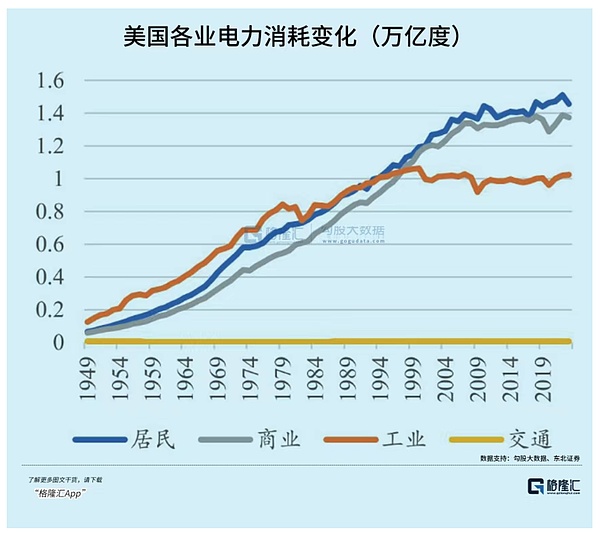
If China's electricity consumption structure is used as the standard for the "world factory", then the total power generation of the United States is about 3.29÷32.2%≈10.2 trillion kWh.
Even if the standard is lowered a little, it means that electricity production must double.
What is needed for power generation? Raw materials can be bought directly, provided that there is a power plant.
How to build a power plant? First, money is needed, and second, people are needed.
Look at the figure below, the value scale of the existing US power system...
To double the power generation, it will not only cost trillions of dollars, but also require a lot of manpower. More importantly, this cannot be achieved within a few years.

3.Logistics
Land transportation.
The 400,000-kilometer railway built in the former industrial era is not completely abandoned, but it is already extremely old.
If you want to transport goods across the North American continent on land, the first thing to do is to repair the railways and roads.
In 2021, Biden launched a $1 trillion infrastructure investment plan, of which less than 20% was used for ports, railways, and roads, which can be said to be a drop in the bucket.
In this case, the importance of sea routes is becoming more and more important.
This aspect has been discussed a lot recently, and the most well-known is BlackRock Group's acquisition of Panama's port business.
The biggest role of the Panama Canal is to connect the east and west coasts of the United States. It was once an important tool for the United States to maintain its position as the world's factory. Today, it is also crucial to revitalizing the manufacturing industry.
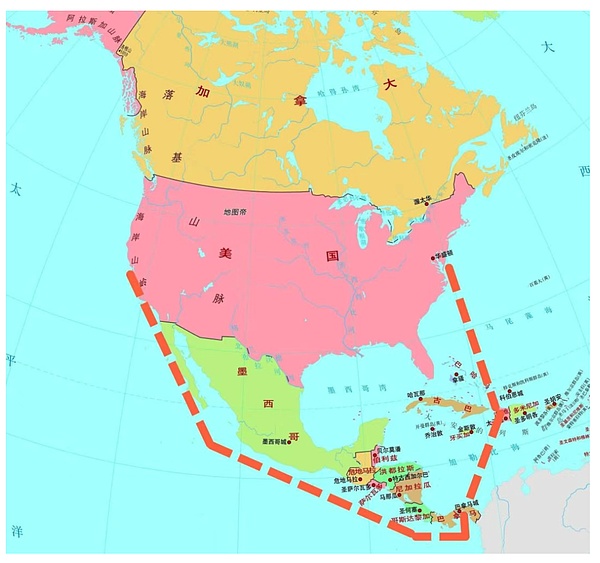
But it's still the same truth.
The premise for a port to play a role is that there are enough goods to transport; and enough goods require that the country's ports of entry and exit have sufficient carrying capacity.
The problem is that the United States does not have any of the top ten ports in the world.
Although the largest port, the Port of New York, has a throughput of 600 million tons, it is still a long way from being a real giant port.
In short, it still takes money, people, and trade to rebuild the prosperity of the port.
This is also not something that can be achieved in a short period of time.
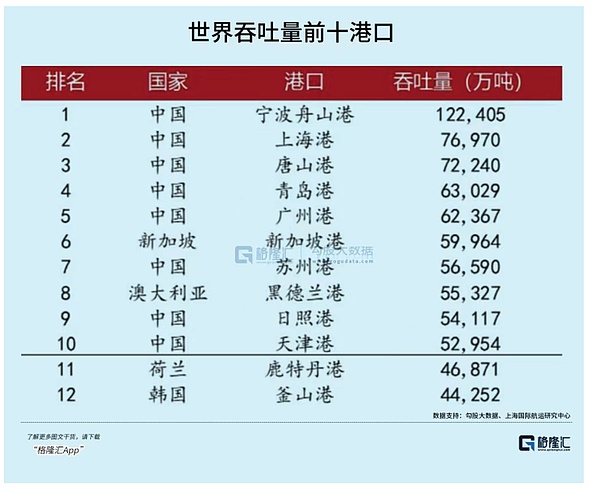
The above list is not comprehensive.
But just looking at these, the cost that Trump needs to spend to promote the return of manufacturing, achieve greatness again, and even make the United States the world's factory again is simply unimaginable.
The "great era" lasted for more than a hundred years, and it was the efforts of several generations that made it "great".
It seems unlikely that Trump will achieve "greatness" in just a few years during his term.
Unless a decisive variable appears.
Epilogue
Strictly speaking, there are only two real world factories in human history, which originated from two energy revolutions.
The first one is Britain, where steam engines freed factories from dependence on human and animal power.
From 1760 to 1860, the productivity of British workers increased 20 times, and 2% of the population contributed half of the world's industrial production.
The second one is the United States. Tariff protection certainly plays a role, but the more important driving force is the application of electricity.
Edison first applied the self-excited generator to lighting and invented the incandescent light bulb, extending the industrial production of human society to the night; Tesla invented the AC generator, which has high power and greatly reduced the cost of power generation, providing huge energy for industry.
The emergence of many new technologies has made the United States truly become the core country of the Second Industrial Revolution.
……
Both are the natural result of being the leader of the energy revolution and greatly improving production efficiency.
The rise of the third "world factory", Dongda, mainly relies on a large number of high-quality labor forces, and has not yet achieved a fundamental breakthrough in production efficiency in most fields, which is fundamentally different from the previous two.
Trump's belief in "making America great again", is it to restore the status of the second-generation world factory, or is it just satisfied with the return of some industries, or even to build a new third-generation world factory?
This may be the most critical variable in this era.
If it is the first two, the problems faced are as mentioned in the second part of this article. The main direction is to restore the previous productivity. The difficulties are basically around money, energy, manpower and time.
If it is the latter, it means making a huge breakthrough in energy or production efficiency, fundamentally rewriting the industrial logic that has been maintained for more than half a century, and production efficiency and wealth creation will evolve tenfold or even dozens of times again...
From easy to difficult, there are at least three possibilities:
1. According to the Tesla model, crazy layoffs will be made to maximize the efficiency of existing resources.
This is already being done, but there is great resistance. Musk, the operator, announced that he will resign from DOGE at the end of May.
2. The most basic things cannot be changed, but we can still change the production relations like the third scientific and technological revolution - that is, what we often call Industry 4.0.
Although it is impossible to achieve a leap in productivity, it can still greatly reduce production costs and reduce dependence on manpower, solving the most pressing human and financial problems of the United States' re-industrialization.
3. Energy revolution, the most reliable one at present is controlled nuclear fusion, but it is still a long way from practical use.
There are three corresponding results:
Partial return of manufacturing industry and resolution of social contradictions, but failure to restore the status of the world's factory;
Restoration of the glory of the second world factory;
The United States continues to lead the new era and become the third generation world factory.
Of course, judging from the current situation, even the easiest first one is so difficult to implement, and the fourth possibility may be greater:
None of the above three will be successful.
 YouQuan
YouQuan
 YouQuan
YouQuan Brian
Brian Joy
Joy Brian
Brian Hui Xin
Hui Xin Joy
Joy Joy
Joy Brian
Brian Hui Xin
Hui Xin Brian
Brian